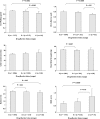Drug Burden Index and physical function in older Australian men
- PMID: 19660007
- PMCID: PMC2732944
- DOI: 10.1111/j.1365-2125.2009.03411.x
Drug Burden Index and physical function in older Australian men
Abstract
Aims: This study evaluated the associations of physical performance and functional status measures with the Drug Burden Index in older Australian men. The Drug Burden Index is a measure of total exposure to anticholinergic and sedative medications that incorporates the principles of dose-response and maximal effect.
Methods: A cross-sectional survey was performed on community-dwelling older men enrolled in The Concord Health and Ageing in Men Project, Sydney, Australia. Outcomes included chair stands, walking speed over 6 m, 20-cm narrow walk speed, balance, grip strength and Instrumental Activities of Daily Living score (IADLs).
Results: The study population consisted of 1705 men (age 76.9 +/- 5.5 years). Of the 1527 (90%) participants who reported taking medications, 21% were exposed to anticholinergic and 13% to sedative drugs. The average Drug Burden Index in the study population was 0.18 +/- 0.35. After adjusting for confounders (sociodemographics, comorbidities, cognitive impairment, depression), Drug Burden Index was associated with slower walking speed (P < 0.05), slower narrow walk speed (P < 0.05), balance difficulty (P < 0.01), grip weakness (P < 0.01) and poorer performance on IADLs (P < 0.05). Associations with physical performance and function were stronger for the sedative than for the anticholinergic component of the Drug Burden Index.
Conclusions: Higher Drug Burden Index is associated with poorer physical performance and functional status in community-dwelling older Australian men. The Drug Burden Index has broad applicability as a tool for assessing the impact of medications on functions that determine independence in older people.
Figures

Comment in
-
Anticholinergics, antimuscarinics or atropinics? About the words in pharmacology.Br J Clin Pharmacol. 2010 May;69(5):561-2. doi: 10.1111/j.1365-2125.2010.03633.x. Br J Clin Pharmacol. 2010. PMID: 20573094 Free PMC article. No abstract available.
Similar articles
-
Drug Burden Index associated with function in community-dwelling older people in Finland: a cross-sectional study.Ann Med. 2012 Aug;44(5):458-67. doi: 10.3109/07853890.2011.573499. Epub 2011 Apr 15. Ann Med. 2012. PMID: 21495785
-
Physical and cognitive performance and burden of anticholinergics, sedatives, and ACE inhibitors in older women.Clin Pharmacol Ther. 2008 Mar;83(3):422-9. doi: 10.1038/sj.clpt.6100303. Epub 2007 Aug 22. Clin Pharmacol Ther. 2008. PMID: 17713474
-
Sedative load and functional outcomes in community-dwelling older Australian men: the CHAMP study.Fundam Clin Pharmacol. 2014 Feb;28(1):10-9. doi: 10.1111/j.1472-8206.2012.01063.x. Epub 2012 Jul 31. Fundam Clin Pharmacol. 2014. PMID: 22849300
-
Association of Drug Burden Index with grip strength, timed up and go and Barthel index activities of daily living in older adults with intellectual disabilities: an observational cross-sectional study.BMC Geriatr. 2019 Jun 24;19(1):173. doi: 10.1186/s12877-019-1190-3. BMC Geriatr. 2019. PMID: 31234775 Free PMC article.
-
Drug Burden Index in older adults: theoretical and practical issues.Clin Interv Aging. 2014 Sep 9;9:1503-15. doi: 10.2147/CIA.S66660. eCollection 2014. Clin Interv Aging. 2014. PMID: 25246778 Free PMC article. Review.
Cited by
-
Analysis of anticholinergic and sedative medicine effects on physical function, cognitive function, appetite and frailty: a cross-sectional study in Australia.BMJ Open. 2019 Sep 4;9(9):e029221. doi: 10.1136/bmjopen-2019-029221. BMJ Open. 2019. PMID: 31488480 Free PMC article.
-
Quantifying Anticholinergic Burden and Sedative Load in Older Adults with Polypharmacy: A Systematic Review of Risk Scales and Models.Drugs Aging. 2021 Nov;38(11):977-994. doi: 10.1007/s40266-021-00895-x. Epub 2021 Nov 9. Drugs Aging. 2021. PMID: 34751922 Free PMC article.
-
Interventions for reducing anticholinergic medication burden in older adults-a systematic review and meta-analysis.Age Ageing. 2023 Sep 1;52(9):afad176. doi: 10.1093/ageing/afad176. Age Ageing. 2023. PMID: 37740900 Free PMC article.
-
Associations between different measures of anticholinergic drug exposure and Barthel Index in older hospitalized patients.Ther Adv Drug Saf. 2013 Dec;4(6):235-45. doi: 10.1177/2042098613500689. Ther Adv Drug Saf. 2013. PMID: 25114784 Free PMC article.
-
Benzodiazepine (BZD) use in community-dwelling older adults: Longitudinal associations with mobility, functioning, and pain.Arch Gerontol Geriatr. 2014 Sep-Oct;59(2):331-7. doi: 10.1016/j.archger.2014.04.017. Epub 2014 May 6. Arch Gerontol Geriatr. 2014. PMID: 24880195 Free PMC article.
References
-
- Fried TR, Bradley EH, Williams CS, Tinetti ME. Functional disability and health care expenditures for older persons. Arch Intern Med. 2001;161:2602–7. - PubMed
-
- Shi S, Morike K, Klotz U. The clinical implications of ageing for rational drug therapy. Eur J Clin Pharmacol. 2008;64:183–99. - PubMed
-
- Hilmer SN, McLachlan AJ, Le Couteur DG. Clinical pharmacology in the geriatric patient. Fundam Clin Pharmacol. 2007;21:217–30. - PubMed
-
- McLean AJ, Le Couteur DG. Aging biology and geriatric clinical pharmacology. Pharmacol Rev. 2004;56:163–84. - PubMed
-
- Fick DM, Cooper JW, Wade WE, Waller JL, Maclean JR, Beers MH. Updating the Beers criteria for potentially inappropriate medication use in older adults: results of a US consensus panel of experts. Arch Intern Med. 2003;163:2716–24. - PubMed
Publication types
MeSH terms
Substances
LinkOut - more resources
Full Text Sources

